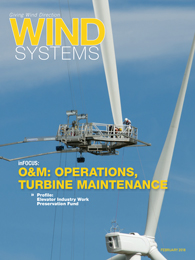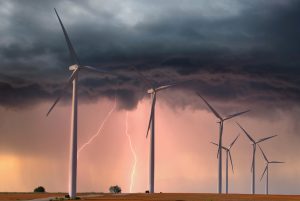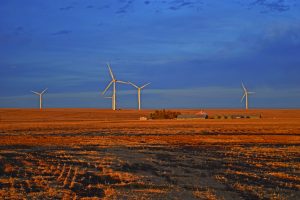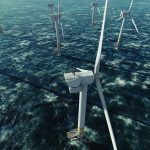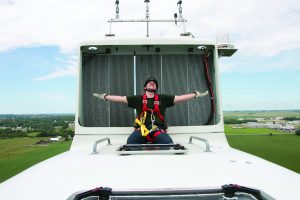With the increasing demand for carbon-free renewable energy, more companies are turning to wind power as a source for their energy needs. Although this presents a good deal of potential for the manufacturers of wind turbines and their components, the technological challenges of providing a reliable product that operates with minimal maintenance or repair is increasingly daunting.
That is because enormous forces are at work on the individual internal components.
Turbine shaft bearings, planetary and sun gears, and rotating shafts, for example, operate under high-load conditions that involve direct metal-on-metal contact, often in poor lubricating conditions. With components increasing in size, these forces only become more extreme.
When this occurs, turbine components made of hardened steel or metal alloys can still break down as a result of extreme wear, scuffing, surface fatigue, pitting, and galling.
Given the sheer size of wind turbines, wind-farm operators must bear significant costs for overhauls that often involve logistics involving cranes for on-site repairs.

“When you have to bring a crane to change the main shaft bearing, for example, it is not only the cost of the new bearing but also the total work to exchange the part,” said Dr. Florian Rovere of Oerlikon Balzers, a company that produces specialize PVD coatings for components in North America.
“It can quickly become $100,000 or $200,000 for the overhaul,” Rovere said. “So all of a sudden, your green energy becomes super expensive, which is why wind-farm operators really want to extend the longevity of the components as much as possible.”
To address this issue, coatings and surface treatments can significantly extend the service life of wind-turbine components. Today, this is being accomplished through the application of specialized physical vapor deposition (PVD) coatings and nitriding treatments that increase surface hardness and durability.
By applying coatings optimized for these types of punishing environments, components benefit from increased surface hardness and a much lower coefficient of friction. As a result, these critical parts do not have to be replaced as frequently, if at all, reducing maintenance and unplanned downtime while improving wind-turbine performance.
PVD Coatings
Physical vapor deposition encompasses a wide range of vacuum deposition methods. It essentially covers components with thin coatings to increase their surface hardness and durability, lower the friction coefficient, and resist corrosion.
By applying components with PVD coatings designed for such demanding conditions, not only is the surface hardness and durability increased, but essential parts are far less likely to fail, if at all. As a result, maintenance and unexpected downtime are drastically reduced.
A specialized PVD coating that is particularly effective is Balinit C, which can be applied in thicknesses of 0.5 to 4 micrometers on roller bearings and gear parts.
The WC/C ductile carbide carbon coating has a high load-bearing capacity, even when used with insufficient lubrication or dry contact.

Due to its low-friction coefficient, the coating can drastically reduce fretting corrosion and pitting. By forming an effective barrier between metal-on-metal contacts, the coating reduces metal structural damages such as white-etch cracks and fatigue failure.
According to Rovere, there are alternatives to PVD coatings that are at times used on wind-turbine components like black oxide.
Black oxide is a coating produced by a chemical reaction between the iron on the surface of a ferrous metal and oxidizing salts. After a post-treatment with oil, the surface provides protection against corrosion, improved lubricity, and prevents galling during metal-to-metal interactions.
However, black oxide is not durable and can be worn away quickly in repetitive, high-load applications.
Nitriding
There are limitations to the size of products that can be coated with PVD, such as the ring gears in modern wind turbines that can measure up to two to three meters in diameter.
For these types of large gears, Rovere said a nitriding process can be used instead to increase the surface hardness of the metal.
“Nitriding is a heat-treating process that diffuses nitrogen deep into the surface of a metal to create a case-hardened surface,” Rovere said. “Because it is not a coating, it does not affect the overall dimensions of the component.”
Although traditional gas nitriding costs less, plasma nitriding has the advantage of making the treatment more precise by minimizing warpage and distortion while achieving a higher load-bearing capacity.

In an FZG pitting test, Balitherm Ionit, a plasma-nitriding process from Oerlikon Balzers, exhibited five times less roundness deviation and seven times better planarity than gas nitriding on a two-meter diameter ring gear.
Another potential application for plasma nitriding is for treating the surfaces of large bearing cages used with wind-turbine bearings to increase the sliding wear resistance against the rollers.
The process can be used on components up to three meters in diameter, 10 meters in length, weighing up to 40 tons.
“Compared to gas nitriding, the tolerances for roundness, planarity, and parallelism can be adhered to much better, even with such large parts as the ring gears, and that is of great importance for the service life of a system in which enormous forces are at work simply because of its size,” Rovere said.
















